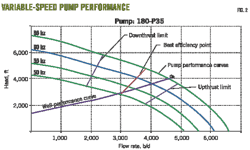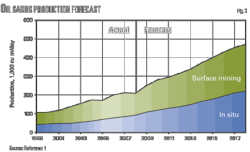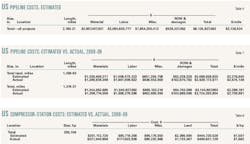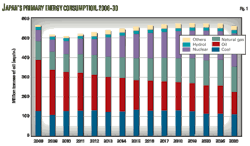DRILLING CONSORTIUM—1: Rig management structure optimizes drilling off Norway
Bjorn Thore Ribesen, Arild Saasen
Det norske oljeselskap ASA
Oslo
Kjell Arild Horvei
Halliburton
Stavanger
Tove Magnussen, Tormod Veiberg
AGR Petroleum Services AS
Oslo
| Based on a presentation to the SPE/IADC Drilling Conference and Exhibition, Amsterdam, Mar. 1-3, 2011. |
A well management company together with several operating companies and an integrated service provider optimized a 3-year exploration drilling campaign off Norway.
This combined effort provided excellent health, safety, and environment performance, and efficient exploration drilling (101 m/day on average) at a low cost that continued to improve throughout the drilling campaign.
The improvements were a result of how the companies organized and managed the drilling projects. During this campaign five different operators used this management system.
This first part of a two-part series explains the management system and the health, safety, and environment (HSE) concerns. The concluding part will discuss the integrated service provider, logistics, risk management, and technical performance of the campaign.
Drilling off Norway
Currently more than 50 operators and partner companies are active or have interests in drilling operations off Norway. But only a handful of companies are sufficiently large enough to maintain a complete exploration drilling department.
Larger companies may have in-house drilling departments with continuous drilling campaigns with long-term rig contracts for their exploration activities. For other companies, the drilling activity is less. These smaller companies, therefore, have to drill wells discontinuously, leading to a costly and inefficient drilling operation.
To avoid the costly and inefficient drilling operation, several operators formed a rig consortium in 2006. It consisted of BG Norge Ltd., Endeavour Energy Norge AS (now VNG), Revus Energy AS (now Wintershall), Marathon Petroleum Norge AS, Lundin Norway AS, Det norske oljeselskap AS (DNO), and Pertra AS.
Petra merged with the Norwegian assets of DNO to form Det norske oljeselskap ASA in 2007.
The consortium hired the Bredford Dolphin semisubmersible drilling rig and a well management company, AGR Petroleum Services AS, to conduct drilling management and detailed engineering.
The consortium also contracted a main integrated services provider (Halliburton) to minimize the interface between different drilling endeavors and to optimize the logistical activity.
Integrated service contracts
Integrated service contracts are not new. Various authors have discussed several methods of integrated services. For instance, Haugland summarizes that "too often, even the best intended integrated drilling operations get stranded."1 He concluded that successful integrated services contracts need to replace the one-sided focus on technology and instead focus on people.
Discussed frequently 2 decades ago was the use of different types of turnkey drilling contracts. De Wardt discussed turnkey contracts in which the service contracts were made by the drilling contractor.2 He also presented the benefits of using combined contracts for related services.
Gehan and Rospide described an example of how such contracts could be improved by creating a more open planning team.3
Herbert suggested how to involve service providers directly in the turnkey contracts.4 He concluded "by spreading the risks, and appropriate rewards, all entities in the drilling and development scenario will feel proprietorship of the program, thereby leading to increased efficiency, which translates into effective cost management."
Osmundsen et al. discussed the design of drilling contracts.5 Instead of looking at turnkey contracts, the presentation described different systems for incentives for the supplier. These incentives also included the complexity of HSE requirements.
Turnkey contracts, however, are more frequently used in land-based drilling than in offshore drilling.6 None of these presentations on turnkey contracts, however, emphasized exploration drilling.
Another paper by Osmundsen et al. discusses the exploration drilling productivity on the Norwegian continental shelf (NCS) and its recent decline in productivity, defined in meters/day.7 The paper notes that drilling productivity in the 4-years 2005-08 was on average 43 m/day, much lower than the 76 m/day average in the previous 4 years 2001-04.
Although no studies on drilling productivity are available for many regions, the paper states that a decrease in drilling productivity is a global tendency. It concludes that the reduction in offshore exploration drilling productivity correlates with water depth and reservoir depth, revealing that drilling speeds are slower in more complicated operations.
Incentive systems seem to have had less influence on observed drilling productivity. As previously mentioned, the average drilling productivity for Det norske's wells in the drilling campaign was 101 m/day, with a continuous improvement throughout the entire campaign.
All the mentioned authors assumed that the operator is a major company. In conclusion, Osmundsen et al. states that "Rig contractors must be challenged to design contracts, which are suitable for new small companies on the NCS. These will require a different approach to risk sharing than existing agreements."8
The following sections discuss a successful example on how such an approach, using a well management company and an integrated service provider produced cost-efficient exploration drilling with full focus on health, safety, and environment concerns.
Rig consortium
The rig consortium management idea involved a company representing different operators during a drilling campaign. The left side of Fig. 1 illustrates this for five different operators.
The benefit of such a company is greater than just running operations for several smaller operators. All the operators could use the well management company's steering procedures and best-practice guidelines. Furthermore, the same group of engineers design and run all operations, resulting in a continuous operation with the best potential of learning from experience as the drilling operations proceed.
A major operator often drills a well in one region using its regional office (right side of Fig. 1). The regional office will apply its regional best-practice guidelines. These guidelines may differ from the best-practice guidelines used by other offices of the operator.
If the rig moves to another location, a different organization might run the operations, causing the rig crew to react differently to the new organization, thus creating a greater risk for misunderstanding information.
In this respect, a well management company increases the safety of exploration drilling campaigns independent of the size of the operator.
As with drilling, the consortium optimizes the handlng of HSE issues because the HSE group remains the same throughout the whole drilling campaign. Among different operators, each has its own HSE procedures with strengths and weaknesses. With the well management model, it is possible to adopt the individual strengths from all operators.
The rig crew will have the same HSE department to deal with and more or less the same HSE procedures during the campaign even though the operators may be different. Bridging documents enforce the rig owners' procedures and operator requirements.
This use of continuity of the HSE practice contributes to good HSE performance during the drilling campaign.
Operational practice
The well management company ran the daily drilling operation. To be efficient, however, the drilling operation required regular weekly meetings between management and operating companies as well as operator participation during the regular daily morning rig meetings.
It was possible technically to run morning rig meetings with attendants joining the meeting from anywhere. To optimize the operation, however, it was important to minimize the number of individuals calling into the meetings. Most attendants, therefore, joined the meetings through a limited number of hubs.
Operator's activity
The operator's duty is part of the foundation of all drilling operations in Norwegian waters. It is an essential principle in the framework from the Norwegian government and the Petroleum Safety Authority's (PSA) regulations to make sure the operator handles its duty.
The operator's organization was set up to handle the planning phase and run the operational phase with full control. Fig. 2 shows the organization during the planning phase, and Fig. 3 shows the structure during the operational phase.
In June 2010, PSA highlighted some new areas for oversight:9
• Organizational factors, such as training and qualifications of personnel responsible for critical operations.
• Technical and operational control systems for well control
• Operational rules, regulations. and certification with regards to maintenance of blowout preventer (BOP) systems.
All of these items were of the utmost importance to the operators in the drilling consortium from the beginning of the campaign in 2007; 3 years before the new PSA highlights.
The drilling consortium performed a common procedure and acceptance test to qualify the rig. Early in the planning for the campaign, the consortium identified a need for special attention towards safety improvements for critical equipment. This was also in line with the main philosophy of prioritizing HSE issues for preventing major accidents.
Det norske developed a new data gathering and analysis system for monitoring indicators of major accidents. This work has been brought one step further and introduced to all Det norske drilling operations.
The consortium followed an annual audit and verification that it regularly reviewed and continuously followed up through the management committee.
Early on, the consortium emphasized improving environmental and organizational factors. Training and qualifications were essential because the rig arrived from a long yard stay and had partly inexperienced personnel.
The rig owner had a system for skills, training, and qualifications associated with every job category. The operators put in extra resources through the well management team that followed up daily with training and guiding the personnel to make use of the right processes and safety tools, such as different types of risk assessments and checks. This resource included a safety coach position on the rig site.
The campaign involved the conducting of a series of audits and verifications throughout the operations. In these endeavors, all operators participated with the well management company as the acting party in charge.
One item identified early was the need for improving procedures to ensure the existence of two barriers against spills to the sea. This involved an independent audit followed by creating organizational, procedural, and operational plans. As a result of the follow up of the audit and through implementation of the identified measures, the operation experienced a marked decrease in the number of spills to the sea.
As previously mentioned, the operators concentrated on issues that potentially could lead to major accidents. In particular, the items with the highest priority were the BOP, crown-mounted compensator valve, and riser system. Malfunction or wrong operation of any one of these potentially could lead to major accidents.
To prevent accidents, the operators prioritized and performed separate audits and verifications on safety critical equipment. These audits and verifications ensured safe operations, appropriate maintenance, certifications, and functionality in accordance with regulations.
The operators put on the rig site an internal control officer to ensure the follow up of audits and verifications.
The managing committee consisting of all operators in the consortium could easily become divided because of individual motives for their decisions. To avoid this, the committee improved the decision making process based on actions sanctioned by the managing committee and put in place by the drilling management company.
This made it fairly easy to agree on plans and associated funding for audits and improvement projects throughout the campaign.
HSE issues
The indisputable target of thorough planning was safe and efficient operations.
The planning process involved making continual improvements to reflect experiences and items learned from previous operations, regardless of the individual operator.
The plan gave the involved parties, such as operators, service providers, and rig owner the opportunity to optimize their internal planning processes with respect to different activities.
In general, Fig. 4 shows the activities carried out in the scheme.
The well design risk assessment involved the evaluation of the base case well design based on known drilling hazards, technological robustness, flexibility, and contingencies. The risk level was based on the different operator's operational risk matrix. This was normally a five by five matrix that balanced probability by consequence and defined the limits of low, medium, and high risk.
The well management team and the operator, rig owner, rig manager, and main service provider project manager ran the risk-assessment sessions.
The site-specific risk and emergency response analysis was a quantitative risk analysis for the drilling rig at the specific location and a corresponding emergency response analysis. The risk was measured against the operator's risk-acceptance criteria.
The well-specific risk assessment evaluated the planned operation section by section, including risk to personnel, the environment, and to the operation and assets.
The objectives were to identify all relevant risk elements and potential measures for reducing risk to as low as reasonably practicable. The operator's operational risk matrix indicated the risk level.
The well management team, involving personnel from the entire project—operator, rig owner, and service suppliers—ran these sessions.
Drill well on paper was a workshop process for optimizing detailed procedures based on a section recommendation.10 The offshore drilling supervisor ran the workshop sessions and the participants were mainly offshore personnel and those daily involved in the drilling operation.
Participation in the activities illustrated in Fig. 4 was crucial to the quality of the well operation. Heavy involvement was required from the rig owner, rig crew, including the safety organization, and the main service provider and the other service companies. To ensure involvement, the activities were postponed or rescheduled if the required participants were unavailable.
The use of the same team over a period of time allows for carrying out the activities efficiently. This leads to a focus on experience transfer between the different wells with different operators.
During operations, a safety coach on the rig had an independent role, reporting to the drilling supervisor and spending the majority of time with the crew in the workspace. The safety coach had the main task of coaching the crew in:
• Safe working practices.
• Rig owners procedures.
• Use of observation technique and proactive reporting.
• Use of last-minute risk assessment, such as take-two check or the four-point check.
The take-two check was the informal last-minute risk assessment in which the persons involved take 2 min before starting a job to think it through and evaluate potential risks and barriers.
The four-point check was a more formal documented last-minute risk assessment in which the involved persons use a predefined check list to think through the job and identify barriers and mitigate potential risks.
In addition, the safety coach participated in prejob meetings, safe-job analysis, handover meetings, and other safety-related activities.
As in the planning phase, the management company followed the operation onshore throughout the contract period; hence, by the same personnel independent of the operator operating the rig and of the well program and well slots.
Different operators supported the follow-up with competence and experience ensuring a substantial basis for running the operation. This gave a continuous follow-up of issues and a potential for evaluating trends, effect of improvement measures, and experience transfer between the operators and wells.
The operations focused on planning of the work, both onshore and offshore, believing that good planning activities will result in safe and efficient operation.
The well management team and the operators also supported the rig owner's long-term work to create a safe working environment on the rig. This was done by observation techniques, barrier thinking, and pro-active reporting as instruments to increase the understanding of risk and barriers in the offshore crew and to create participation from the crew itself in the continuous improvement work on the rig.
The enterprise involved the service suppliers as well as the rig crew. This continuous support limited the number and necessity for short-term improvement campaigns that normally would have been initiated by the different operators independently.
As mentioned previously, the first year of operation was characterized by much project work in addition to the drilling operation. It was necessary to finalize upgrading of the rig to the required standard, and to train an inexperienced rig crew. This resulted in several incidents, giving a negative trend on the HSE statistics H and H2-values.
The H-value is the number of lost time incidents/million hr worked and the H2-value is the number of lost-time incidents and medical treatment incidents/million hr worked.
Most of these cases were low potential incidents. Fig. 5 shows the H and H2-value trend during the contract period.
The figure shows that after about 1 year of operation, the trend changed and the number of incidents resulting in personnel injuries decreased steadily. It is believed that this was a consequence of the long-term cooperation between all parties in the project as described previously.
Likewise, during the contract period, both the rig owner personnel and the service company personnel gave positive feedback concerning the rig site's working environment. It is thought that the contributing factor to this was the long-term focus and the predictability achieved through the continuity in the operation.
Typical concerns addressed on a continuous basis were:
• Acknowledgement of compliance exemptions.
• Reporting of unwanted incidents and accidents.
• Working environment.
• Investigations.
• Maintenance.
• Audits.
There were several concerns that were followed up over a longer period, across wells and operators. These included BOP and spare parts, crown-mounted compensator valve, and riser running tool certificate.
These concerns were addressed until closed, through regular weekly HSE meetings, biweekly operational meetings, and a few specific meetings when necessary. OGJ
References
1. Haugland, K., "We have Built the Rooms, Our Work Processes are in Place—But now What—Where is the Value?," Paper No. SPE 128683, SPE Intelligent Energy Conference and Exhibition, Utrecht, Netherlands, Mar. 23-25, 2010.
2. De Wardt, J.P., "Drilling Contracting in the Nineties," Paper No. SPE 19902, SPE/IADC Drilling Conference. Houston, Feb. 27-Mar. 2, 1990.
3. Gehan, T., and Rospide, J.P., "Incentive Contract," Paper No. SPE 21900 and DOI: 10.2118/21900-MS, SPE/IADC Drilling Conference, Amsterdam, Mar. 11-14, 1991.
4. Herbert, R.P., "Drilling in the 90's: A Service Company Perspective," Paper No. SPE 21904 and DOI: 10.2118/21904-MS, SPE/IADC Drilling Conference, Amsterdam, Mar. 11-14, 1991.
5. Osmundsen, P., Toft, A., and Dragvik, K.A., "Design of Drilling Contracts—Economic Incentives and Safety Issues," Energy Policy, Vol. 34, 2006, pp. 2,324-29.
6. Moomjian, C.A. Jr., "Contractual Insurance and Risk Allocation in the Offshore Drilling Industry," Drilling Contractor, January-February 1999, pp. 19-21.
7. Osmundsen, P., Roll, K.H., and Tveteras, R., "Exploration Drilling Productivity at the Norwegian Shelf," Journal of Petroleum Science and Engineering, Vol. 73, 2010, pp. 122-28, and DOI: 10.1016/j.petrol.2010.05.015.
8. Osmundsen, P., "Drilling Contracts and Incentives," Energy Policy, Vol. 36, 2008, pp. 3,138-44.
9. Petroleum Safety Authority, http://www.ptil.no/nyhetsarkiv/category64.html?archiveID=month&time=6%3A2010, Nov. 1, 2010.
10. De Wardt, J.P., "Well Delivery Process: A Proven Method to Improve Value and Performance While Reducing Costs," Paper No. SPE 128716, SPE/IADC Drilling Conference and Exhibition, New Orleans, Feb. 2-4, 2010.
The authorsMore Oil & Gas Journal Current Issue Articles
More Oil & Gas Journal Archives Issue Articles
View Oil and Gas Articles on PennEnergy.com









